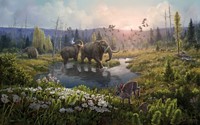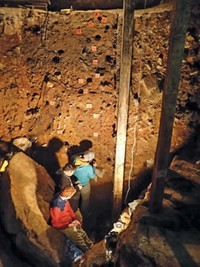Advertisement
Grab your lab coat. Let's get started
Welcome!
Welcome!
Create an account below to get 6 C&EN articles per month, receive newsletters and more - all free.
It seems this is your first time logging in online. Please enter the following information to continue.
As an ACS member you automatically get access to this site. All we need is few more details to create your reading experience.
Not you? Sign in with a different account.
Not you? Sign in with a different account.
ERROR 1
ERROR 1
ERROR 2
ERROR 2
ERROR 2
ERROR 2
ERROR 2
Password and Confirm password must match.
If you have an ACS member number, please enter it here so we can link this account to your membership. (optional)
ERROR 2
ACS values your privacy. By submitting your information, you are gaining access to C&EN and subscribing to our weekly newsletter. We use the information you provide to make your reading experience better, and we will never sell your data to third party members.
Biological Chemistry
Looking for Answers in Ancient DNA
Analysis of DNA from fossils is resolving questions in paleontology and anthropology
by CELIA M. HENRY, C&EN WASHINGTON
March 29, 2004
| A version of this story appeared in
Volume 82, Issue 13
Science Fiction author Michael Crichton has a knack for stories that challenge the bounds of scientific plausibility; yet his novels are grounded firmly enough in scientific reality to leave the reader wondering, "Could this really happen?" In "Jurassic Park," scientists cloned dinosaurs using DNA extracted from insects encased in amber. Scientists may not be cloning dinosaurs in the real world, but they are using ancient DNA to address some of the shortcomings of traditional methods in paleontology and anthropology. Speakers at Pittcon described research in this field.
Citing the example of Dinornis, a genus of extinct flightless birds from New Zealand, Eske Willerslev, a molecular biologist at the University of Oxford, in England, and the University of Copenhagen, in Denmark, described how traditional paleontology can fail.
Basing their conclusions on fossils, paleontologists originally thought that there were three species of Dinornis, one smaller and two larger. However, no other supporting evidence could be found for three species. Instead, a team on which Willerslev participated, led by Alan Cooper of Oxford's zoology department, found that the mitochondrial DNA from the three "species" was identical on both of the major New Zealand islands, with differences between the populations on the two islands [Nature, 425, 172 (2003)].
DNA analysis can provide a way around such ambiguities, but working with ancient DNA can be difficult.
DNA degrades over time through a variety of mechanisms. While an organism is alive, its DNA is under constant assault from spontaneous hydrolysis and oxidation. Such damage would eventually prove fatal, if not for the DNA repair system. After an organism dies, the DNA repair system stops working, but DNA degradation continues. Hydrolysis and removal of the cyclic amine groups from DNA are common forms of degradation in ancient DNA.
The best places to find ancient DNA are those places that are cold and protected. That means that the majority of intact ancient DNA samples will be found in caves or at high altitudes or closer to the poles.
FROM A CHEMICAL standpoint, ancient DNA is nearly indistinguishable from its modern relatives. Therefore, scientists who hope to make paleontological or anthropological claims based on ancient DNA need to make sure that their samples are pristine. Because the polymerase chain reaction (PCR), which is used to amplify DNA samples, can start with as little as one DNA molecule, contaminants are a big problem when trying to use ancient DNA to place fossils genetically in their correct position in a family tree. In addition, as an enzymatic process, PCR can be inhibited by DNA degradation, pointed out Hendrik Poinar, an assistant professor of anthropology at McMaster University in Hamilton, Ontario.
Therefore, analyses with ancient DNA need to be held to strict criteria of authentication, Willerslev believes. They need to be conducted in facilities that are isolated from other PCR labs to minimize the possibility of contamination with modern DNA. And they must be reproducible in an independent laboratory. Finally, the results must make phylogenetic sense. For example, Willerslev said, the DNA sequence obtained from a sample purported to be a wooly mammoth should resemble the sequence from a modern elephant.
Finding enough ancient DNA in macrofossils to do analyses is a problem, Willerslev said. To sidestep that problem, scientists are looking for DNA from sources other than intact fossils. Willerslev uses ice cores and soil samples from permafrost. Poinar is using coprolite--fossilized feces--as a source of DNA.
Ice cores that Willerslev and his colleagues from the University of Copenhagen took from Greenland contained DNA sequences from a variety of species [Proc. Natl. Acad. Sci. USA, 96, 8017 (1999)]. Most of the sequences were similar to those from species now found in polar and alpine environments. Willerslev and his coworkers believe that the DNA comes from organisms that lived on the ice caps.
The permafrost samples contain much more DNA than the ice cores, Willerslev said. Most of the permafrost cores he studied in Copenhagen are from the Beringia region of eastern Siberia. The samples range in age from 10,000 to 8.1 million years old. The DNA levels in the soil dropped off in the older samples.
The soil samples provided diverse DNA, even in the absence of obvious microfossils, Willerslev said. Such DNA analyses could supplement the pollen and bone records. However, the analysis needs to be improved to get at the species level. Right now, DNA can only be distinguished at the family level.
Poinar finds coprolite to be an excellent source of nuclear DNA. "It's a matter of understanding the chemistry," he said. He believes that condensation products account for the long-term stability of DNA in such samples.
He likes using feces because it contains DNA both from the animal and from what it ate. Such information can be used to reconstruct the paleoclimate. For example, coprolite from ground sloths revealed that an area in Nevada, which is now a desert, was once a juniper woodland.
In the future, Poinar plans to use coprolite from Native American sites in Texas to determine whether Native Americans came from Asia in a single migration wave that then dispersed or arrived in three separate migrations. "We will see how many different haplotypes existed in the gene pool about 8,000 years [ago]. This will give us an idea of how many waves there have been," he told C&EN.
William Goodwind, a lecturer in forensic genetics at the University of Central Lancashire, in the U.K., is trying to determine if there was a relationship between modern humans and Neanderthals--or if Neanderthals were simply an evolutionary dead end. Figuring out whether Neanderthals contributed to the modern European gene pool requires looking at Neanderthal population genetics.
NEANDERTHALS EVOLVED in Europe from about 300,000 to 35,000 years ago. They abruptly disappeared 30,000 to 40,000 years ago, when they were replaced by the Cro-Magnon, who were among the earliest modern humans. There is little evidence of interactions between Neanderthals and Cro-Magnon.
There are a number of hypotheses about the origin of the modern European gene pool, Goodwin said. DNA analysis theoretically could help resolve such disputes. Such analysis has been carried out with mitochondrial DNA (mtDNA), which is separate from the genome found in the nucleus. MtDNA is maternally inherited and highly variable. It serves as a molecular clock to date the population.
One Neanderthal skeleton that has been used for such analysis is that of an infant found buried in the Mezmaiskaya cave in 1994. Mezmaiskaya is located in the northern Caucasus mountains on the Black Sea, where the cold temperature, high altitude, and limestone surroundings help preserve the DNA.
The infant could be anywhere between a seven-month fetus and a two-month-old infant. A rib bone was used for all the analyses. Radiocarbon analysis dates the skeleton as about 30,000 years old, near the end of Neanderthals.
Goodwin and his colleagues sequenced 345 base pairs of a region of mtDNA known as hypervariable 1, using Neanderthal-specific PCR primers. They also did direct sequencing and subcloning and sequencing of the PCR products. The sequences were quite different from modern humans, and a phylogenetic analysis does not suggest that modern humans contain any Neanderthal DNA.
Goodwin would like to analyze Cro-Magnon DNA for evidence of a contribution from Neanderthal. One of the problems with analyzing Cro-Magnon DNA is that it's difficult to determine whether or not it has been contaminated by modern DNA.
A recent publication from biologist Svante Pääbo's group at Max Planck Institute for Evolutionary Anthropology in Leipzig, Germany, finds no evidence of Neanderthal mtDNA contribution to early modern humans [PLoS Biol., 2, 313 (2004)].
Pääbo, who was not a speaker at Pittcon, and his coworkers analyzed 24 Neanderthal and 40 early modern human remains, of which four Neanderthal and five early modern humans were in good enough condition to suggest that the DNA had been preserved as well. The mtDNA sequences from the four Neanderthals were similar to sequences from previously analyzed Neanderthals. The early modern humans did not contain such sequences.
However, the authors write that the results "do not definitively resolve the question of a possible Neandertal contribution to the gene pool of modern human since such a contribution might have been erased by genetic drift or by the continuous influx of modern human DNA into the Neandertal gene pool." In addition, if any Neanderthal mtDNA sequences resemble those of modern humans, they might be erroneously dismissed as contamination when in fact they came from the fossils.
Evolutionary anthropologists would like to analyze the nuclear genes because they may have a longer history than the mtDNA that extends before the Neanderthal-modern human split, Goodwin said. However, obtaining ancient nuclear DNA is even more difficult than obtaining ancient mtDNA.
IN ADDITION TO ancient DNA analysis, some scientists are analyzing proteins in fossils. Because ancient DNA is hard to quantify, Matthew Collins, affiliated with the departments of biology and archeology at the University of York, in England, also looks at two bone proteins: mineralized collagen, which represents 99% of the bone, and osteocalcin, which represents about 0.2%. He suggested that both the DNA and osteocalcin might survive by binding to the minerals in bone.
Because protein degradation is different at high and low temperatures, Collins tries to establish a thermal age of samples. Most degradation of proteins happens during warm phases of history. DNA thermal age estimates of Neanderthal samples suggest that even though the samples are roughly 40,000 years old, they have the same age as an equivalent sample held for 20,000 years at a constant temperature. Collins pointed out that although proteins in fossils are more stable than DNA, collagen is typically absent after about 200,000 years.
Collins also looks at osteocalcin in many fossils, and his team putatively identified the protein in dinosaurs using immunological detection. Using mass spectrometry, his team can now see that osteocalcin is much better preserved than collagen, but even in well-preserved samples, not much of the amino-terminus of the protein survives. Although it may survive longer than DNA, osteocalcin, with only 49 amino acids, is such a small protein that it's not good for phylogeny studies, Collins said.
"Jurassic Park" is not yet a reality, but who knows how far the field could go? In the meantime, scientists will keep using ancient DNA to answer questions about how the world used to be and how we came to be who we are.
MORE ON THIS STORY





Join the conversation
Contact the reporter
Submit a Letter to the Editor for publication
Engage with us on Twitter